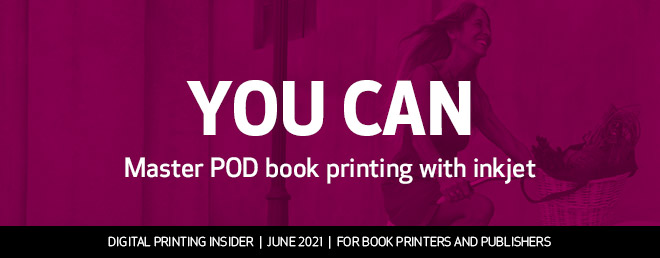How Inkjet Technology Is Transforming Digital Book Production—Again
Historically speaking, there’s no question digital technology changed how we consume content. When e-delivery grew in popularity, there were concerns that printed books might be on the decline. But the preference for printed and bound books remained strong—and even grew, increasingly requiring quick production. Again, digital technology rose to the occasion by making print on demand (POD) and short runs possible.
Now, the latest advances in production inkjet are radically transforming digital book printing again, making this market segment even more viable and robust. Today’s inkjet doesn’t merely accommodate shorter runs and “book of one” orders with speed, productivity, quality, and efficiency—it makes them profitable. As a result, more book printers are gaining a competitive advantage by transitioning jobs from offset and toner to inkjet.
The Transformation at Bookmasters
For a “feet on the ground” perspective on the current book printing segment and the factors driving this shift, Pat McGrew, senior director of production software and services for Keypoint Intelligence–InfoTrends, explored the transformation of book production with Brad Sharp, director of manufacturing at Bookmasters, Inc. and Ken Fultz, who recently retired as general manager of the Ohio-based integrated publisher services company.
“We’re harnessing production inkjet to get content to the customer at the lowest cost and fastest speed.” Ken Fultz
Part of Follett Corporation, Bookmasters is a strategic partner of Baker & Taylor, LLC, and one of the country’s largest providers of editorial and design, e-book conversion, printing, printed book and e-book distribution, and marketing services for publishers and authors. Offering traditional offset as well as digital toner and inkjet production, the company’s annual revenue is about $13.5 million, with $7.0 million from digital.
During a recent webinar, the three looked at how Bookmasters is harnessing production inkjet to serve additional publishers, better meet ambitious SLAs, and, in the words of Fultz, “get content to the customer at the lowest cost and fastest speed.”
Making the Inkjet Decision
Bookmasters took its time evaluating the performance and potential of inkjet. Having assured themselves that inkjet delivered color, quality, and productivity that matched or surpassed their digital toner devices, the Bookmasters team confidently purchased a Canon VarioPrint i300 sheetfed inkjet press and a Canon ColorStream 3900 web-fed inkjet press for monochrome work.
“Most of our publishers readily understood the value of inkjet from a business standpoint.” Brad Sharp
The Bookmasters team was very transparent with customers during the process, proactively discussing the transition and allowing publishers to make the decision about how they wanted their products produced based on price, quality, and fulfillment needs.
“Most of our publishers readily understood the value of inkjet from a business standpoint,” Sharp said. “They know it is inherently better for shorter runs, single-step personalization, faster time frames, and cost control. On the operations side, they recognize the advantages of less make ready and reduced manual intervention during production. Inkjet helps them grow their title list and customer set without overprinting. Plus, inkjet allows them to accommodate new kinds of books coming on the market that incorporate digital experiences.”
The Payoff from Production Inkjet
With the decision to add production inkjet, Bookmasters was able to transfer nearly 40 percent of its color toner volume to the VarioPrint i300 at lower cost and higher productivity, as well as add 25 percent to its color capacity while eliminating four color toner devices. With the ColorStream 3900, it was able to transfer an entire shift from a Timson web press, economically doing mono runs from 300 to 13,000 at a higher quality and service level and adding 20 percent to its capacity while eliminating three toner devices.
Bookmasters was also able to diversify its customer base and be more responsive to new inquiries and opportunities. A big part of that growth is print on demand. Currently, Bookmasters fulfills about 10,000 POD books on average, with a typical run size of just seven copies. They also handle up to 250 “book of one” requests a day, according to Fultz. Asked if customers see book of one workflow as cost effective and a realistic value-add, he immediately responded, “absolutely, especially in high-demand, direct-to-consumer publishing environments.
“POD is a sound inventory management solution.” Fultz said. “You don’t need to print it and hope you sell it anymore. Now you can sell it, print it, ship it.”
That, said Sharp, is a critical consideration right now with more publishers looking more carefully at the total cost of book manufacturing.
“You don’t need to print it and hope you sell it anymore. Now you can sell it, print it, ship it.” Ken Fultz
“Total cost includes storage, obsolescence, and other factors. You can’t just look at pennies per copy. Shorter runs may cost a few pennies more per copy, but you are selling them all. By enabling short-run digital and print on demand, inkjet solves the return issue as well as replenishment.”
Plus, the Advantages of Automation
Finally, Fultz and Sharp highlighted the advantages of inkjet’s easy workflow automation capabilities.
“End-to-end automated workflow is critical for getting as much payback as possible. With Canon’s PRISMA workflow solutions, the switch over to the new inkjet presses was easy and seamless for us and for our customers—no disruptions. And our print-on-demand work is touchless from EDI to order queue. The first human touch is when it’s unloaded from the printer.
“Now we try to drive as much business as possible to inkjet—traditional, short-run digital, print on demand. There’s viability for big runs, too, and still be competitive. It’s what gets our books into customers’ hands faster and grows our business.”
Did you know?
Book Smart Suite helps enable cross-channel integration between print and digital media.
